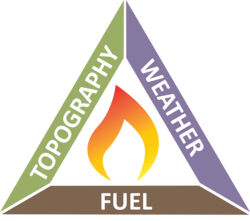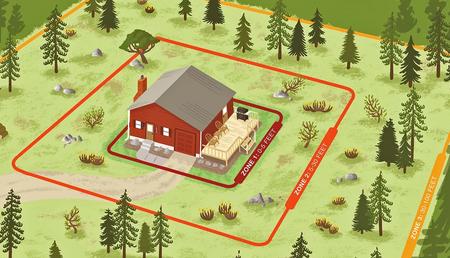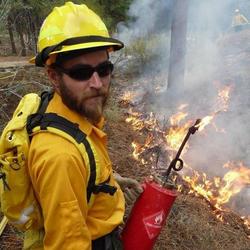Fire Experts Meet to Discuss Preparedness and the Urgency of Hazardous Fuel Reduction
By Bobby Woelz, CO-CEM®
CRESTONE, CO — On August 29th, the Saguache County Office of Emergency Management, in partnership with Baca Grande Emergency Services and Crestone Volunteer Fire Department, organized a tour of the Baca Grande subdivision for the Colorado Division of Fire Prevention and Control and the Rio Grande National Forest.
The tour's main goal was to enhance the understanding of Crestone and the Baca Grande's layout and potential hazards among State and Federal firefighting partners. Firefighters conducted assessments of primary roads, access points, risks, narrow passages, and evacuation routes. This tour increased knowledge of the area for State and Federal firefighters. Firefighters found several potential hazards within the subdivision, including overgrown vegetation, narrow passages, a gated emergency egress route, and areas where firefighting equipment could have difficulties maneuvering.
This tour also promoted collaboration among federal, state, and local firefighters, improving communication and coordination, critically essential elements of a unified and efficient emergency response.
"Urgent Need for Hazardous Fuel Reduction to Mitigate Our Wildfire Risk"
During the tour, a prominent message resonated — the need for hazardous fuel reduction. As wildfires increase in size and intensity, the urgency to reduce the fuel load is critical. The tour emphasized the importance of this continuous effort: creating defensive buffer zones that can slow the rapid spread of wildfires.
"Fuels modification work is our only way to reduce the severity of wildfires," said Shannon Moore, acting Fire Management Officer for the Rio Grande National Forest. The interaction of three key factors, often called the 'fire behavior triangle' — fuel, topography, and weather — influences a fire's spread and intensity. "We cannot change the two primary fire behavior influencers of weather and topography, but we can have a meaningful impact on what the wildfires have available to burn." Moore noted the need for broad-scale fuel reduction work to reduce hazardous fuel loading that has accumulated over the past 100 years. We can promote healthier forest conditions through mechanical and non-mechanical treatments, slash piles, and prescribed broadcast burning. These measures, in turn, will better protect our Communities through strategically planned projects.
Supervisory Forester Adam Moore with the Colorado State Forest Service emphasized that his agency likes to work with homeowners and communities on two different scales of fuel mitigation. Homeowners should focus on the Home Ignition Zone, which is the home and the area around the house. This is also the primary area determining a home’s survival during a wildfire. Moore said, “These three simple actions are the most critical: Creating a fire-free 5’ zone around the home, reducing places where embers can land, and decreasing the amount of flammable vegetation within 100 feet.” Communities can work on larger scales by creating fuel breaks to decrease the intensity of a fire coming into a community and providing a place where firefighters can safely suppress the fire. “These areas are often designed to tie in with roads, ridges, or rivers, and they’re often 300’ + wide, such as the efforts Baca is taking on their common land,” Moore added.
"We urgently need to reduce hazardous fuels to lower wildfire risk in Crestone and the Baca Grande," emphasized Bobby Woelz, Saguache County's Emergency Management Director. "This area requires extensive landscape-scale thinning and prescribed burning." Woelz also expressed his support for using mechanical methods for project completion, emphasizing their efficiency and cost-effectiveness compared to manual labor by hand crews. Mechanical thinning, which involves using equipment like skid steers and masticators, is typically a faster and more cost-effective approach.
The overgrowth is so extreme that if a catastrophic wildfire occurs, it will be unsafe for our firefighters to respond. Climate change will only continue to intensify wildfires. We cannot expect firefighters to stop wildfires under increasingly extreme conditions and heavy fuel loads. Woelz added, "I compare it to trying to fight a hurricane. We do not have 'hurricane fighters' to go out and stop storms; we evacuate and clean up afterward. A wildfire, under the current circumstances, will be no different."
Firefighters will always do their best to protect homes; however, it is essential to recognize that protecting your property from wildfire is ultimately your responsibility. During a wildfire, firefighters may not be present at your residence, and they will only protect homes when the conditions allow them to do so safely. Therefore, residents must proactively prepare their homes and property to withstand a wildfire without depending on firefighter intervention.
"Thinned Forests are Healthier Forests."
People love trees. People hold a profound affection for trees, often seeing them as sentient entities that evoke deep emotional connections. However, it is vital to recognize that responsible forestry goes beyond cutting down individual trees. Responsible forest management includes returning forests to their natural state, paying attention to how close together trees are, the kinds of trees, how old they are, and gaps in the tree cover. Additionally, reducing the number of trees decreases stress and competition in forested areas susceptible to insects and disease. This approach protects the holistic well-being of every tree in the forest.
Forest management is crucial for supporting a balanced mix of species, biodiversity, forest regeneration, and age diversity across the landscape. Wildfire mitigation plays a vital role in preserving the ecological harmony of forests while reducing potential devastation caused by high-intensity wildfires. It fosters healthier forests that support a wider variety of plant and animal species, enhancing overall biodiversity. Proactively thinned forests are also more resilient in the face of climate change impacts, such as prolonged droughts and rising temperatures. Healthy forests contribute to ecological balance, making them better prepared to withstand wildfires and environmental challenges.
The recent tour organized by Saguache County's Office of Emergency Management highlighted the urgent need for hazardous fuel reduction. We need collaborative efforts from public and private landowners and continued investments in restoration and forest health to protect our community. To effectively respond to wildfires that are growing in intensity, we need to create defensive buffer zones and promote healthier forest conditions. We must proactively take steps to protect our homes and the environment.
Download a PDF of this Article
About the Author
Bobby Woelz was appointed as Director of Saguache County’s Office of Emergency Management in 2017. Bobby is a Colorado Certified Emergency Manager (CO-CEM®) and received the Emergency Manager of the Year Award for the San Luis Valley All-Hazards Region from the Colorado Emergency Management Association in 2019. He is an active member of San Luis Valley’s Wildfire Council and the Local Emergency Planning Committee. He also serves as Chair of the Emergency Coordination Committee.
With 8 years of experience as a wildland firefighter, Bobby has worked with the Bureau of Land Management and the U.S. Forest Service and has led fuel reduction projects with the Veterans Fire AmeriCorps program for the Student Conservation Association and the Southwest Conservation Corps.


